Salvador Dali's Method to Wake Up our Creative Side
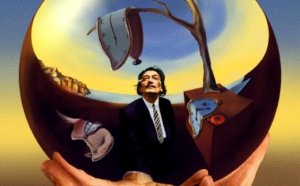

Written and verified by the psychologist Valeria Sabater
Salvador Dali’s method, based on the hypnagogic state, sought to transcend the world of reason and embrace the surreal. He then made it his own and turned it into art. This genius of surrealism created what he himself called “photographs of hand-painted dreams”. Bizarre worlds, frightening but hypnotic panoramas that still fascinate us today.
Many see Salvador Dali as an eccentric man, difficult to understand, often delirious, sometimes controversial and always extreme. However, you can also see a meticulous and infallible side to him. This allowed him to capture his deepest emotions and bring them to light. He was an explorer of the psyche, a “psychonaut” who never needed drugs to achieve creative ecstasy. His mind was undoubtedly the best stimulant around.
“The true painter is one who is capable of painting extraordinary scenes in the middle of an empty desert. The true painter is one who is able to patiently paint a pear surrounded by the tumults of history “
-Salvador Dali-
The method that Dali used to immerse himself in those private and infinite oceans of the surreal is still attracting our attention today. So much so, that his technique has been described as “the hypnagogic vertical nap”. Many creative groups apply his techniques in order to get better ideas. They can remove the filters of reason and train the mind to be more free and more receptive.
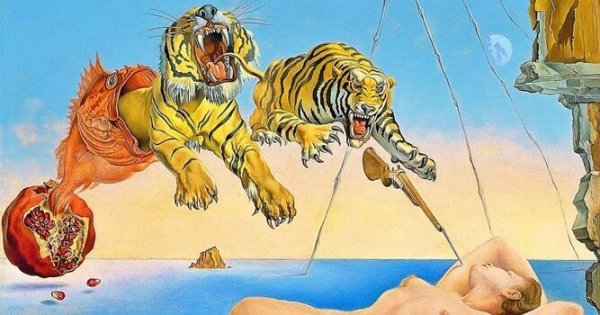
Salvador Dali’s method to awaken and enhance our creativity
Let us observe for a moment one of his most famous works entitled “Dream caused by the flight of a bee around a pomegranate a second before waking up”. This strange but simple title offers us a small clue about Dali’s famous method for creating his works. However, in this painting he wanted to show something else that he had learned by reading Freud. Freud said that many of our dreams are stimulated by sounds, smells or presences from the outside, like the sound of that bee buzzing around us while we sleep.
Dali used to have a siesta, and every time he did, he took a spoon with him. His method, magic, and ritual was the following: after eating he would sit in an armchair. In one of his hands he would hold the spoon and leave a plate on the floor. His nap lasted only a few minutes because his purpose was not to sleep, but to reach the hypnagogic state. Moreover, when he got to the point of deep sleep he knew that the spoon would fall from his hand. The sound of it hitting the plate would wake him up instantly. This was what he wanted.
This technique allowed him to travel between dreaming and waking. That immeasurable ocean where the most amazing beings arise, the strangest creatures of the unconscious world. An in-between state that he visited every afternoon for a few minutes. And where he would take advantage of those moments when the mind is more fluid and hyper-associative than ever.
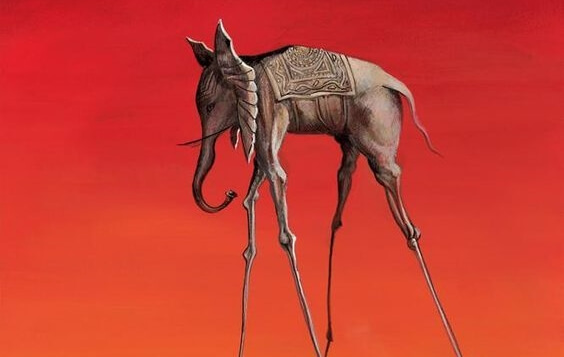
The hypnagogic method is very common in creative minds
Salvador Dali’s method, based on reaching the hypnagogic state, was not discovered by him nor was it unknown to science, psychology and, above all, to the art world. In fact, we know that Lewis Carroll also used something similar as a writer. When reading “Alice in Wonderland” and especially “Alice Behind the Looking Glass“, we can immediately sense that Carroll was also using a purely dreamlike type of narrative and imagery.
He also created a routine method to wake himself up before going into deep sleep. He placed a notebook next to his armchair. In it he described each image that he saw in his subconscious world.
As the hypnagogic state has this curious capacity, it would be good to look at some of its characteristics:
- This state appears in phases 1 and 2 of deep sleep, not REM.
- The hypnagogic state is a phase that we could consider as “pre-sleep”. This is where our brain waves go from beta to alpha.
- In this phase, brief and intense visual and auditory hallucinations usually appear.
- These images are forgotten as soon as we wake up.
- Hypnagogic states or hallucinations are common in children and adolescents.
Authors who have studied this phenomenon, such as Dorfman, Shames, and Kihlstrom, explain that during these states the person has a feeling of “absolute knowledge”, of enlightenment. The mind begins to create multiple associations between memories, intuitions, emotions, thoughts and stimuli from the outside world. It forms an exceptional mishmash with its own real meaning within that “preconscious” state.
However, upon awakening, we dilute, blur and completely forget these images, unless, of course, we follow a strategy similar to Dali’s.
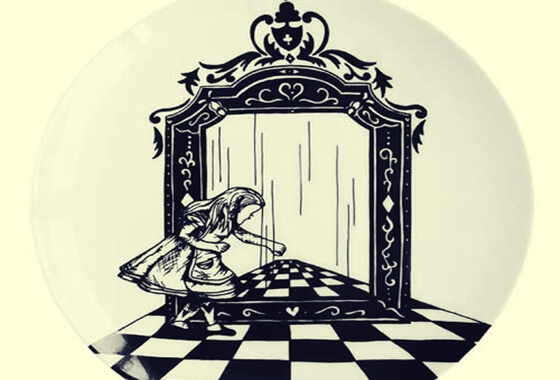
Dali’s method can also be achieved through meditation
It is very possible that by this point we have been intrigued by that hypnagogic state that Dali achieved during his naps. However, we must bear in mind that it is not easy to reach and take advantage of this peculiar phase of sleep. Salvador Dali was a seasoned “psycho-navigator” in that twilight world of the subconscious. It would certainly be difficult for us to get to where he did.
However, in our own way, we can also achieve a very similar effect using meditation to catalyze and enhance the creative process. This is what David Lynch, another genius of the subconscious and the surreal, tells us in his book “Catching the Big Fish“. Meditation pacifies the exterior sound and harmonizes thoughts. And in this way, as we master the technique, we will give way to a more lively and freer mental flow. We’ll reach the dimension that is almost always hidden from our busy minds. The mind that characterizes us, but detaches us almost always from its essences, intuitions and wonders.
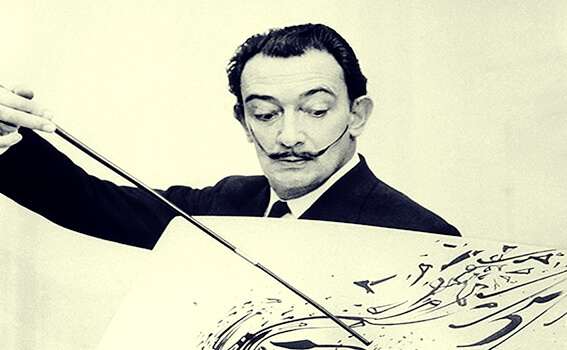
To conclude, although Salvador Dali’s method was not new, he was able to give it an exclusive and unparalleled use. If we wish to enhance our creativity, it is enough for us to allow ourselves to be a little freer, a little more childish even. Let’s not forget to look at our outside and also the depths of our minds, where unbelievable ideas and thoughts most definitely reside.
Salvador Dali’s method, based on the hypnagogic state, sought to transcend the world of reason and embrace the surreal. He then made it his own and turned it into art. This genius of surrealism created what he himself called “photographs of hand-painted dreams”. Bizarre worlds, frightening but hypnotic panoramas that still fascinate us today.
Many see Salvador Dali as an eccentric man, difficult to understand, often delirious, sometimes controversial and always extreme. However, you can also see a meticulous and infallible side to him. This allowed him to capture his deepest emotions and bring them to light. He was an explorer of the psyche, a “psychonaut” who never needed drugs to achieve creative ecstasy. His mind was undoubtedly the best stimulant around.
“The true painter is one who is capable of painting extraordinary scenes in the middle of an empty desert. The true painter is one who is able to patiently paint a pear surrounded by the tumults of history “
-Salvador Dali-
The method that Dali used to immerse himself in those private and infinite oceans of the surreal is still attracting our attention today. So much so, that his technique has been described as “the hypnagogic vertical nap”. Many creative groups apply his techniques in order to get better ideas. They can remove the filters of reason and train the mind to be more free and more receptive.

Salvador Dali’s method to awaken and enhance our creativity
Let us observe for a moment one of his most famous works entitled “Dream caused by the flight of a bee around a pomegranate a second before waking up”. This strange but simple title offers us a small clue about Dali’s famous method for creating his works. However, in this painting he wanted to show something else that he had learned by reading Freud. Freud said that many of our dreams are stimulated by sounds, smells or presences from the outside, like the sound of that bee buzzing around us while we sleep.
Dali used to have a siesta, and every time he did, he took a spoon with him. His method, magic, and ritual was the following: after eating he would sit in an armchair. In one of his hands he would hold the spoon and leave a plate on the floor. His nap lasted only a few minutes because his purpose was not to sleep, but to reach the hypnagogic state. Moreover, when he got to the point of deep sleep he knew that the spoon would fall from his hand. The sound of it hitting the plate would wake him up instantly. This was what he wanted.
This technique allowed him to travel between dreaming and waking. That immeasurable ocean where the most amazing beings arise, the strangest creatures of the unconscious world. An in-between state that he visited every afternoon for a few minutes. And where he would take advantage of those moments when the mind is more fluid and hyper-associative than ever.

The hypnagogic method is very common in creative minds
Salvador Dali’s method, based on reaching the hypnagogic state, was not discovered by him nor was it unknown to science, psychology and, above all, to the art world. In fact, we know that Lewis Carroll also used something similar as a writer. When reading “Alice in Wonderland” and especially “Alice Behind the Looking Glass“, we can immediately sense that Carroll was also using a purely dreamlike type of narrative and imagery.
He also created a routine method to wake himself up before going into deep sleep. He placed a notebook next to his armchair. In it he described each image that he saw in his subconscious world.
As the hypnagogic state has this curious capacity, it would be good to look at some of its characteristics:
- This state appears in phases 1 and 2 of deep sleep, not REM.
- The hypnagogic state is a phase that we could consider as “pre-sleep”. This is where our brain waves go from beta to alpha.
- In this phase, brief and intense visual and auditory hallucinations usually appear.
- These images are forgotten as soon as we wake up.
- Hypnagogic states or hallucinations are common in children and adolescents.
Authors who have studied this phenomenon, such as Dorfman, Shames, and Kihlstrom, explain that during these states the person has a feeling of “absolute knowledge”, of enlightenment. The mind begins to create multiple associations between memories, intuitions, emotions, thoughts and stimuli from the outside world. It forms an exceptional mishmash with its own real meaning within that “preconscious” state.
However, upon awakening, we dilute, blur and completely forget these images, unless, of course, we follow a strategy similar to Dali’s.

Dali’s method can also be achieved through meditation
It is very possible that by this point we have been intrigued by that hypnagogic state that Dali achieved during his naps. However, we must bear in mind that it is not easy to reach and take advantage of this peculiar phase of sleep. Salvador Dali was a seasoned “psycho-navigator” in that twilight world of the subconscious. It would certainly be difficult for us to get to where he did.
However, in our own way, we can also achieve a very similar effect using meditation to catalyze and enhance the creative process. This is what David Lynch, another genius of the subconscious and the surreal, tells us in his book “Catching the Big Fish“. Meditation pacifies the exterior sound and harmonizes thoughts. And in this way, as we master the technique, we will give way to a more lively and freer mental flow. We’ll reach the dimension that is almost always hidden from our busy minds. The mind that characterizes us, but detaches us almost always from its essences, intuitions and wonders.

To conclude, although Salvador Dali’s method was not new, he was able to give it an exclusive and unparalleled use. If we wish to enhance our creativity, it is enough for us to allow ourselves to be a little freer, a little more childish even. Let’s not forget to look at our outside and also the depths of our minds, where unbelievable ideas and thoughts most definitely reside.
This text is provided for informational purposes only and does not replace consultation with a professional. If in doubt, consult your specialist.







